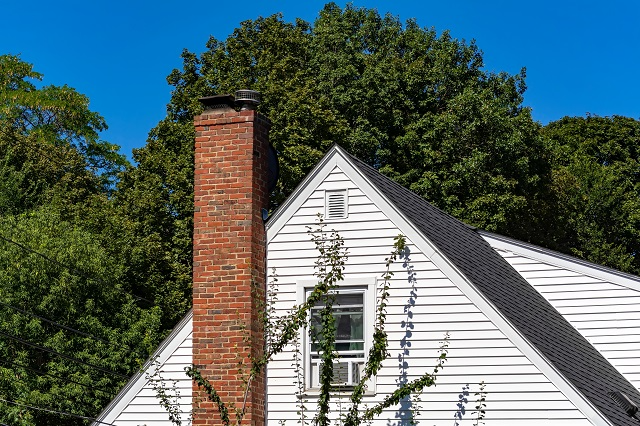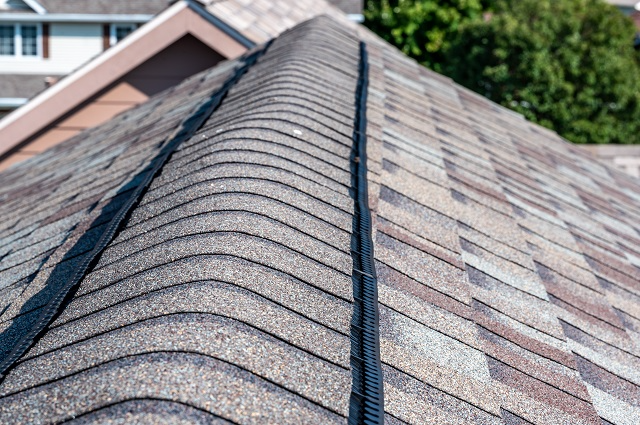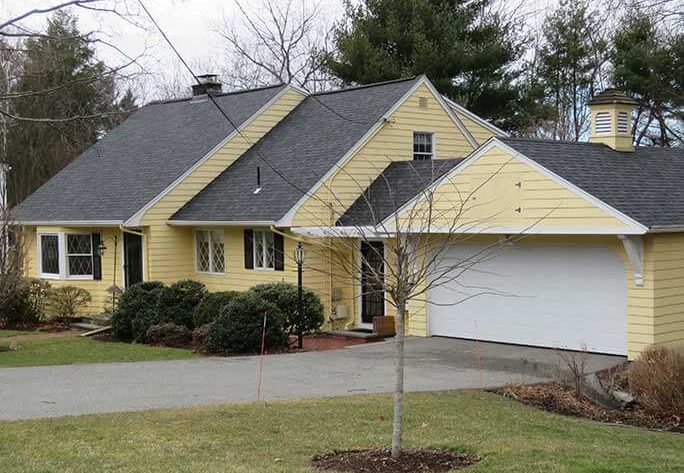Your attic may be a place where you store seasonal decorations and sporting equipment you don’t use frequently, or perhaps you’ve converted it into a bedroom or playroom. The function of your attic goes beyond these typical uses; however, it’s also where you’ll find a lot of the ventilation that’s built into your home.
Gable vents are triangular or rectangular vents in your home’s gables, which are the tallest points of the wall that meet the peak of your roof. If you look from the outside of your home, you’ll be able to see the gable vents at the top of the tallest walls, right up near the point of your roof.
In this guide, we’ll review gable vents in detail, explaining how they work and why they’re vital for the health of your home.
In this article:
- How Gable Vents Work
- Why Are Gable Vents Important?
- Ridge Vents vs. Gable Vents
- Installation Tips for Gable Vents
- Maintaining Your Gable Vents
- Frequently Asked Questions
Keep reading to get to know these important ventilation powerhouses.
How Gable Vents Work

Gable vents are a passive type of ventilation, meaning they don’t require any mechanical parts or fuel to keep your attic well-ventilated. Instead, they rely on natural airflow to move air in and out.
If you have two gable vents on opposite sides of the attic, this will generally work as an intake/exhaust system. The breeze will blow into one vent, cross the attic, and exit through the other vent, taking warm, humid air out with it.
If you’re looking for simple, affordable gable vents, we recommend this set of two from Amazon. They come in three different sizes and can be painted to match your siding or trim.
Gable vents are also often used in conjunction with soffit vents, which are visible when you look up at the part of your roof that overhangs your walls. Warm air from inside the attic naturally rises, pulling cooler air in through the soffits from outside. This creates a cooling effect and pushes humidity back outdoors.
While soffit vents are primarily used for attic ventilation, they can also be used for bathroom exhaust. Here’s an example of a soffit vent designed for bathroom ventilation.
Why Are Gable Vents Important?
Proper attic ventilation isn’t just a matter of comfort; it’s a crucial aspect of home maintenance. Because gable vents are placed at the roof’s peak, they’re a key component in keeping the roofing system in good condition.
Here are some of the advantages that gable vents bring to your attic:
- Temperature regulation: Gable vents help regulate the temperature in the attic, and this extends to the whole house. During warm weather, they allow hot air to escape.
- Moisture control: Gable vents help reduce moisture from building up in the attic by promoting air circulation, which will help prevent mold and wood rot. By the way, this isn’t only a summertime problem; condensation is also created during the winter.
- Roof longevity: Gable vents will help prevent the roof from overheating in the summer, prolonging its life. In the winter, ice dams can occur when the warm attic causes the bottom layer of snow to melt on the roof. If that water is trapped under a layer of insulating snow, it can refreeze overnight or when the temperature drops, causing an ice dam. Gable vents can help prevent this destructive occurrence.
- Energy efficiency: By keeping the attic at a stable temperature, the vents will reduce the workload on your heating and cooling systems, which can result in lower utility bills.
If you want to monitor the conditions in your attic closely, consider installing a temperature and humidity monitoring system. The Temperature/Humidity Sensor by SensorPush is simple to use and has a durable design to withstand dust and other elements.
If your humidity readings are high, Ranch Roofing’s roofing ventilation experts can assess your current ventilation system and recommend updates to provide optimal airflow. Get in touch with us today for a free estimate.
Ridge Vents vs. Gable Vents

Ridge vents and gable vents are both key parts of the attic ventilation system, but they’re two different types of air exhaust vents. While gable vents are installed on the walls of the home, ridge vents are installed along the peak of the roof’s ridge, along the top. You usually can’t see ridge vents from the ground because they’re covered with shingles.
Location isn’t the only factor differentiating the two types of vents. Here are some of the main differences between ridge vents and gable vents:
Airflow Pattern
- Gable vents allow for cross-ventilation, with air entering through one vent and exiting through the other. Depending on the architectural design, they can be less than efficient at equalizing the temperature across the entire attic.
- Ridge vents provide continuous airflow along the roof’s peak, resulting in more uniform temperature regulation across the attic.
Roof Design Compatibility
- Gable vents are best suited for gable roof designs. Their efficacy can vary depending on the attic’s size and layout.
- Ridge vents are more versatile and can be used with various roof designs, including those with complex layouts or multiple peaks.
Aesthetic Impact
- Gable vents are seen from the ground and can be decorative. They come in a range of styles.
- Ridge vents are less visible and don’t impact the home’s aesthetic.
Installation Tips for Gable Vents

Installing gable vents can improve your home’s ventilation and energy efficiency. For the best results, we recommend hiring a professional installer to ensure the vents are placed correctly and minimize the risk of leaks and other issues.
If you want to install the gable vents yourself, however, here are some tips to help:
First, choose the right vent. Most commonly, aluminum gable vents are used, but can also choose wood or vinyl. These aluminum gable vents have a built-in mesh to allow proper airflow while preventing other things, such as pests and water, from passing through.
Measure the area where you’ll be installing the vent to ensure you purchase the right size. Rectangular or square vents are most common, but you might choose a different shape, such as one with a rounded top or an octagonal shape.
Then, make sure you have the right tools available. These include:
- Measuring tape
- Level
- Jigsaw or reciprocating saw
- Drill with bits
- Screws or nails
- Caulking gun with caulk
- Safety gear such as sturdy footwear, gloves, and safety glasses
Set up your ladder and mark the outside of the vent, making sure it’s centered and level. You’ll drill holes at the corners of the outline, then use your saw to cut along the line to create the opening for the vent. Be sure to wear your safety gear to protect your skin and eyes.
Place the vent into the opening and make any necessary adjustments. Then, secure the vent in place with screws or nails before applying caulk around the edges to seal any gaps. Optionally, you can paint the vent to match your home.
Maintaining Your Gable Vents

Once your gable vents are installed, they might need periodic maintenance. A couple of times per year, inspect your vents from the outside and inside the attic to see if there are any signs of damage like cracks or warping. You should also check to see that nothing is obstructing airflow.
If any debris is in the way, remove it. From the attic side, use a soft brush or a vacuum to wipe away any dust. You can also use a sponge with soapy water to clean them if they’re getting grimy.
If there are any pests in your attic, consider that they might be coming in through the vents. You can add fine mesh screening on the attic side to keep insects out if this is an issue. Many gable vents today come equipped with a built-in screen or mesh to keep pests out.
Finally, if you see any damage, such as cracks in the vents or gaps in the seals, repair it right away to prevent further damage.
Final Thoughts
At Ranch Roofing, we can help you determine which type of ventilation your attic needs based on the style of your roof. We can also professionally install your gable vents and perform repairs or replacements if your gable vents aren’t working the way they should. Get in touch with us to learn more and to schedule an estimate.
Frequently Asked Questions
Do gable vents let water in?
Yes, this can be an issue during a heavy rainstorm with a lot of wind. If you’re having a problem with water infiltration, installing a screen on the vent can help trap water that’s being blown in.
Do gable vents let air in or out?
Gable vents do both. Often, depending on which way the wind is blowing, one vent will allow air in while the one on the opposite wall lets air out. When used with soffits, warm air will rise up and the gable vents tend to act more as exhaust vents.
Should gable vents be closed in winter?
No, it’s important to leave your gable vents open in the winter so humidity and warm air can escape. Your attic should be close to the same temperature as the outdoors. Warm air from the house can make the attic too warm in the winter, leading to condensation and mold.
How many gable vents should I have?
Your home should have at least two gable vents opposite one another. Depending on the shape of your roof, though, you may need more. We can help you determine the right number of vents for your home.

